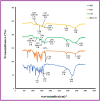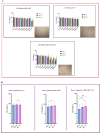Codelivery of resveratrol melatonin utilizing pH responsive sericin based nanocarriers inhibits the proliferation of breast cancer cell line at the different pH
- PMID: 37422485
- PMCID: PMC10329705
- DOI: 10.1038/s41598-023-37668-y
Codelivery of resveratrol melatonin utilizing pH responsive sericin based nanocarriers inhibits the proliferation of breast cancer cell line at the different pH
Abstract
Protein-based nanocarriers have demonstrated good potential for cancer drug delivery. Silk sericin nano-particle is arguably one of the best in this field. In this study, we developed a surface charge reversal sericin-based nanocarrier to co-deliver resveratrol and melatonin (MR-SNC) to MCF-7 breast cancer cells as combination therapy. MR-SNC was fabricated with various sericin concentrations via flash-nanoprecipitation as a simple and reproducible method without complicated equipment. The nanoparticles were subsequently characterized for their size, charge, morphology and shape by dynamic light scattering (DLS) and scanning electron microscope (SEM). Nanocarriers chemical and conformational analysis were done by fourier transform infrared spectroscopy (FT-IR) and circular dichroism (CD) respectively. In vitro drug release was determined at different pH values (7.45, 6.5 and 6). The cellular uptake and cytotoxicity were studies using breast cancer MCF-7 cells. MR-SNC fabricated with the lowest sericin concentration (0.1%), showed a desirable 127 nm size, with a net negative charge at physiological pH. Sericin structure was preserved entirely in the form of nano-particles. Among the three pH values we applied, the maximum in vitro drug release was at pH 6, 6.5, and 7.4, respectively. This pH dependency showed the charge reversal property of our smart nanocarrier via changing the surface charge from negative to positive in mildly acidic pH, destructing the electrostatic interactions between sericin surface amino acids. Cell viability studies demonstrated the significant toxicity of MR-SNC in MCF-7 cells at all pH values after 48 h, suggesting a synergistic effect of combination therapy with the two antioxidants. The efficient cellular uptake of MR-SNC, DNA fragmentation and chromatin condensation was found at pH 6. Nutshell, our result indicated proficient release of the entrapped drug combination from MR-SNC in an acidic environment leading to cell apoptosis. This work introduces a smart pH-responsive nano-platform for anti-breast cancer drug delivery.
© 2023. The Author(s).
Conflict of interest statement
The authors declare no competing interests.
Figures










Similar articles
-
Enhancing Cisplatin Efficacy with Low Toxicity in Solid Breast Cancer Cells Using pH-Charge-Reversal Sericin-Based Nanocarriers: Development, Characterization, and In Vitro Biological Assessment.ACS Omega. 2024 Mar 12;9(12):14017-14032. doi: 10.1021/acsomega.3c09361. eCollection 2024 Mar 26. ACS Omega. 2024. PMID: 38560009 Free PMC article.
-
A comparative study of sericin and gluten for magnetic nanoparticle-mediated drug delivery to breast cancer cell lines.Sci Rep. 2024 Aug 5;14(1):18150. doi: 10.1038/s41598-024-69009-y. Sci Rep. 2024. PMID: 39103485 Free PMC article.
-
Sericin nanomicelles with enhanced cellular uptake and pH-triggered release of doxorubicin reverse cancer drug resistance.Drug Deliv. 2018 Nov;25(1):1103-1116. doi: 10.1080/10717544.2018.1469686. Drug Deliv. 2018. PMID: 29742945 Free PMC article.
-
Pharmaceutical applications of silk sericin.Ann Pharm Fr. 2020 Nov;78(6):469-486. doi: 10.1016/j.pharma.2020.06.005. Epub 2020 Jun 20. Ann Pharm Fr. 2020. PMID: 32569621 Review.
-
Hydrophobic amino acids grafted onto chitosan: a novel amphiphilic chitosan nanocarrier for hydrophobic drugs.Drug Dev Ind Pharm. 2017 Jan;43(1):1-11. doi: 10.1080/03639045.2016.1254240. Epub 2016 Nov 14. Drug Dev Ind Pharm. 2017. PMID: 27802776 Review.
Cited by
-
Biomaterials in Drug Delivery: Advancements in Cancer and Diverse Therapies-Review.Int J Mol Sci. 2024 Mar 8;25(6):3126. doi: 10.3390/ijms25063126. Int J Mol Sci. 2024. PMID: 38542103 Free PMC article. Review.
-
Sericin/polyvinyl alcohol hydrogel optimization for enhanced angiogenesis: a promising strategy for treating chronic osteomyelitis.PLoS One. 2025 Jul 24;20(7):e0328846. doi: 10.1371/journal.pone.0328846. eCollection 2025. PLoS One. 2025. PMID: 40705810 Free PMC article.
-
Dual pH/redox-responsive hyperbranched polymeric nanocarriers with TME-trigger size shrinkage and charge reversible ability for amplified chemotherapy of breast cancer.Sci Rep. 2024 Apr 12;14(1):8567. doi: 10.1038/s41598-024-57296-4. Sci Rep. 2024. PMID: 38609391 Free PMC article.
-
Sericin coats of silk fibres, a degumming waste or future material?Mater Today Bio. 2024 Oct 24;29:101306. doi: 10.1016/j.mtbio.2024.101306. eCollection 2024 Dec. Mater Today Bio. 2024. PMID: 39534681 Free PMC article.
-
Recent Insights into the Potential and Challenges of Sericin as a Drug Delivery Platform for Multiple Biomedical Applications.Pharmaceutics. 2025 May 26;17(6):695. doi: 10.3390/pharmaceutics17060695. Pharmaceutics. 2025. PMID: 40574008 Free PMC article. Review.
References
Publication types
MeSH terms
Substances
LinkOut - more resources
Full Text Sources
Medical

